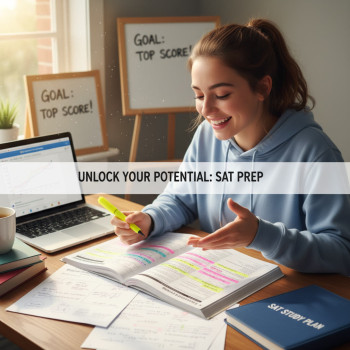Why Negative Thoughts About SAT Scores Feel So Big
We all know the feeling: you glance at a practice test score, or you read a college’s statistics, and suddenly a small thought blooms into a storm. What starts as a whisper — I didn’t do as well as I wanted — can quickly become a chorus of catastrophizing voices: I’m not smart enough, I’ll never get into college, this is it for me. Sound familiar? You’re not alone, and those thoughts are not facts.
The SAT is a high-stakes, high-stress event in many students’ lives. It covers two main sections — Evidence-Based Reading and Writing and Math — each scored 200 to 800 for a combined total from 400 to 1600. That structure gives the test a tidy frame, but it doesn’t capture the messy human reactions that come with test pressure. Those reactions are normal, but they can become self-sabotaging if left unchecked.
First: Name the Thought, Then Shrink It
Before you can fix negative thinking, you need to get curious about it. What are you telling yourself? Is it an unhelpful generalization, like I always fail tests, or a mind reading move, like they think I’m not capable?
A quick practice you can do anywhere
- Spot the thought: When anxiety rises, pause and write the exact sentence in your head.
- Label it: Is it fortune-telling, all-or-nothing thinking, or personalizing?
- Ask for evidence: What facts support this thought? What facts contradict it?
- Reframe: Turn it into a more balanced statement, like I didn’t hit my target on this practice test, but with a focused plan I can improve.
This sequence might seem small, but it reintroduces reason into an emotional moment. Think of it like shining a flashlight into a dark room; once you can see clearly, your fear often loses power.
Why Some Negative Thoughts Persist
Negative thoughts stick because they feel protective. Your brain thinks it’s preventing disappointment by bracing for the worst. Unfortunately, that same protection can freeze progress. Two common patterns that keep negative thinking alive are rumination and avoidance.
Rumination vs. productive reflection
Ruminating is replaying the same worry loop without moving toward a solution. Productive reflection is noticing what went wrong and making a plan to try a different approach next time. The trick is to time-box your reflection: give yourself 15–30 minutes to analyze a low score, then pivot to one concrete action.
Avoidance hides as busyness
Sometimes students stay busy with low-impact activities because it feels safer than practicing the hard parts. That’s understandable. To counter it, schedule short, accountable practice sessions with clear goals — not vague intentions.
Practical Cognitive Tools to Reframe Negative Thoughts
Cognitive reframing is a powerful skill you can build with practice. It doesn’t magically make stress disappear, but it changes the narrative from helplessness to a manageable challenge.
Common negative thoughts and helpful reframes
| Negative Thought | Reality Check | Helpful Reframe |
|---|---|---|
| I’m not smart enough for the SAT | SAT performance is a mix of knowledge, strategy, and practice, not a fixed trait | I can learn the skills and strategies I need; improvement is possible with focused practice |
| A low practice test means I’ll fail for real | Practice tests are diagnostics, not destiny | This score shows where to focus my practice; it’s a useful map, not a final grade |
| If I don’t get into my dream school, my future is over | Many paths lead to meaningful outcomes; colleges are one of many choices | I’ll aim for my goals, but I can also build alternatives that lead to success |
Keeping a small table like this in your study notebook or phone can be a fast go-to when negative thoughts pop up.
Concrete Study Strategies That Reduce Anxiety
Anxiety drops when you replace unknowns with plans. Here are study methods that do double duty: they improve scores and quiet negative thinking because they’re measurable and repeatable.
- Micro-practice sessions: 25–40 minute focused blocks on one question type, then review mistakes for 10 minutes.
- Targeted weaknesses: Use practice test diagnostics to identify the 2–3 question types that cost you the most points, then drill those topics.
- Simulation with variation: Take full-length tests under timed conditions occasionally, but also do shorter targeted sets to build confidence.
- Active review over passive reading: Explain a concept aloud, teach it to a friend, or write a one-paragraph cheat-sheet.
These practices build a sense of mastery. When you can point to a clear plan and small wins, the inner critic loses credibility.
How to Read Practice Tests Without Spiraling
Practice test results are feedback, not judgments. The way you read them determines whether you feel defeated or motivated.
A compassionate test-score review
- Record the score, but don’t live there. Note it, log it, and move on to analysis.
- Break down errors into categories: careless mistakes, knowledge gaps, timing issues, and strategy errors.
- Plan immediate next steps: one correction activity for each error category identified.
- Celebrate one thing you did well on that test, however small.
When you adopt a structured review process, each practice test becomes a problem-solving workshop rather than a final verdict on worth.
Strategies for Test Day Anxiety
Test day brings its own brand of pressure. Here are tools you can use that day to keep negative thoughts from hijacking your performance.
- Focus on process, not outcome: Repeat a short checklist before each section — breathe, read instructions, scan the section, pace yourself.
- Use a 3-breath reset: If a question triggers panic, close your eyes, take three slow breaths, and refocus. Your brain needs oxygen to think clearly.
- Start easy to build momentum: On each section, answer the problems you find easiest first, then come back to harder ones.
- Time awareness without obsession: Check the clock strategically (every 10–15 minutes) but avoid constant clock-watching which fuels stress.
When Negative Thoughts Become Persistent: Seek Support
If negative thoughts about SAT scores are overwhelming or interfere with daily life, it may be time for extra support. That support can be academic, emotional, or both. Tutors and mentors can help with skills and strategy, while counselors can support anxiety management.
One option is personalized tutoring that combines test strategy with emotional support. For example, Sparkl’s personalized tutoring offers 1-on-1 guidance, tailored study plans, expert tutors, and AI-driven insights that can help you turn data into action and reduce uncertainty. Working with a tutor can be especially powerful when you’re stuck in a negative loop — an experienced tutor helps you translate a discouraging score into a clear, step-by-step improvement plan.
Sample 8-Week Plan to Turn a Low Score Into Momentum
This sample plan is meant to illustrate how small, consistent steps build confidence. Adjust pacing based on your schedule and baseline.
| Week | Focus | Weekly Hours | Key Activity |
|---|---|---|---|
| 1 | Diagnostics and goal setting | 5–7 | Full practice test, error log, set 1–2 measurable goals |
| 2 | Targeted skill building | 6–8 | Drill two weakest question types, micro practice |
| 3 | Timed strategy | 6–8 | Section-timed practices, pacing strategies |
| 4 | Full practice and reflection | 5–7 | Full test, structured review, adjust plan |
| 5 | Advanced tactics | 6–8 | Complex problem solving, evidence-based reading techniques |
| 6 | Simulated tests | 7–9 | Two full tests under realistic conditions, review |
| 7 | Fine-tuning | 5–7 | Targeted drills on lingering weaknesses |
| 8 | Polish and rest | 3–5 | Light review, sleep hygiene, mental routines for test day |
Notice how this plan alternates practice with review, so you don’t just grind endlessly. That alternation reduces burnout and helps maintain perspective.
Rebuilding Confidence With Small Wins
Confidence isn’t an all-or-nothing trait. It’s a bank you deposit into with small, repeatable successes. Even tiny victories — answering a tough Math question correctly, finishing a timed Reading passage, sticking to your study schedule — compound over weeks.
Ways to create small wins
- Set micro-goals: 10 targeted problems, a specific time improvement per section, or a consistent weekly study streak.
- Keep a visible progress log: Seeing improvement over time is evidence you’re moving forward.
- Reward effort, not perfection: Celebrate following your plan, even if scores aren’t perfect yet.
Perspective: The SAT Is Big, But Not Infinite
College admissions matter, yet the SAT is one part of a larger picture. Admissions teams consider essays, recommendations, extracurriculars, and other achievements. A single test score doesn’t define your intelligence, character, or future. Remembering that broader context reduces the pressure that breeds negative thinking.
That said, if the SAT is important to you, treat it with the respect of a focused plan. Combine emotional tools with tactical practice and, if it fits your needs, supportive resources like one-on-one tutoring. Sparkl’s personalized tutoring and AI-driven insights are examples of how tailored help can convert anxiety into actionable steps, but the core work — practice, reflection, and resilience — comes from you.
Real Student Example: Turning a 30-Point Setback Into Progress
Consider Maya, a fictional but realistic composite. Maya took a practice test and scored 50 points below her target. Instead of spiraling, she used the following steps:
- She wrote down the negative thought: I’m never going to reach my goal.
- She labeled it as an overgeneralization and asked for evidence: Past shortfalls were followed by progress when she focused practice.
- She did a focused review, found timing issues on the math section, and created a 6-week plan concentrating on pacing and specific problem types.
- She scheduled two simulated tests and one weekly timed section practice to build pacing skills.
- She checked in with a tutor for targeted strategy feedback and used a practice log to track small wins.
After six weeks of deliberate work, Maya’s practice scores rose and her negative self-talk quieted. The hard part wasn’t the score alone; it was learning to respond differently to setbacks.
Final Thoughts: Make Compassion Your Study Superpower
Negative thoughts about SAT scores are painful, but they’re also signals. They tell you where fear lives and where you can practice a new response. Treat yourself like someone worth coaching. When you respond with curiosity, structure, and kindness, you give yourself the best chance to improve and to feel steady under pressure.
And remember, asking for help when you need it is a strength, not a weakness. Whether that help is a study partner, a school counselor, a mental health professional, or personalized tutoring that offers 1-on-1 guidance and tailored study plans, support can transform worry into progress.


A Gentle Checklist to Keep by Your Desk
- Spot the negative thought and write it down
- Label the thinking error and ask for evidence
- Create one measurable action to address the issue
- Schedule a short practice session to follow the action
- Celebrate a small win and log your progress
Keep Going — You’re Doing Important Work
Working toward a strong SAT score is about more than numbers. It’s training in persistence, strategy, and self-compassion. Negative thoughts will show up — that’s part of being human. The skill is learning to notice them, interrogate them, and respond with a plan that moves you forward.
If you want help translating practice into progress, consider pairing your effort with personalized support. A tutor can offer technical strategies and steady encouragement, turning discouraging scores into clear, solvable problems. With a thoughtful plan and a little kindness, those negative thoughts lose their grip and you get to see just how capable you really are.
Now take a breath, write down one small next step, and try it. That small step is the beginning of a new story.















No Comments
Leave a comment Cancel